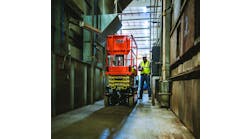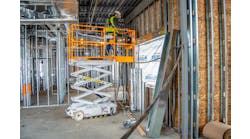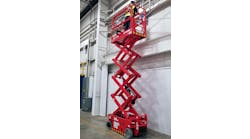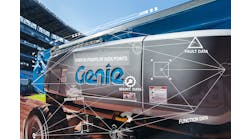Gene Torrence sat by himself on the porch of a small building without furniture on Airline Highway in Baton Rouge. Nobody was calling on the phone and a delivery truck and a 120-foot manlift was in a ditch and the driver was blaming him. After leaving a good position as manlift division manager for Head & Engquist Equipment, he wondered what possessed him to put everything he owned into starting his own rental company in the late 1990s, the era of consolidation. Everybody he knew told him he was crazy and he wondered if they were right.
But Torrence had a willingness to work hard and do what it took, with a love for the rental business and aerial equipment. With his then-partner, Anthony Lubano, and one mechanic, John Reed, Torrence delivered and picked up equipment, helped fix them in the shop when he had to, and worked however many hours it took to get the work done. Torrence's wife Brenda, a legal secretary by profession, joined Aerial Access doing a little of everything and is still with the company handling legal and property issues, payroll, human resources, insurance, collections and a wide range of general services.
Already armed with nearly 30 years experience in the aerial rental business, with contacts and friends among contractors and customers he'd worked and talked with for decades, Torrence was confident he could build a rental business. Torrence gradually began surrounding himself with top-quality service personnel, people he'd worked with on and off for years or even decades, men who knew how to fix machines. A lot of people could replace parts and get machines operating, but not everyone could understand and diagnose complex problems — but his people could. He also found sales people with relationships and history in the industry.
Aerial Access Equipment grew to four locations and a market area extending from Houston to Pensacola, Fla., with a fleet of more than 1,400 machines. Aerial Access grew the old-fashioned way with relationships and exemplary service in a market segment dominated by national companies where contractors depend on national account relationships for discounts and don't like to jeopardize that elite status by giving business to a local guy.
“We understand that,” says Torrence. “So we go after the contractors that go inside the plants, we build those relationships. Relationship selling, that's our forté. We can compete with the big guys because they are more focused on the bottom line where we're more focused on personal service, personal attention. You need decisions made, I'm right here. They come and ask me and it's ‘yes’ or ‘no.’”
Torrence says when a dispute arises, Aerial Access mostly favors the customer. “If I have to issue a credit for $500, it's usually no problem; I want that guy's business next year. We don't have to call a regional vice president, and the regional vice president doesn't have to call somebody else to do credits. These are decisions that we make every day. Being locally owned, offering 24-hour service, the relationship building we do puts us in front of the customers.”
Torrence and his staff do marketing south Louisiana style by building relationships and friendships. Some of those friendships go back decades — they grew up together, went to school together, started out in the job force together. In a lot of cases, Torrence and other top Aerial Access people knew contractors when they were starting out and now have evolved into decision-making positions with the companies they work for.
“I spent a lot of years in outside sales and got to know a lot of people,” Torrence says. “And that's what helped me with this business. All those years I worked for other guys, although I wasn't making a whole lot of money, I was meeting a whole lot of influential people. Some of them were just workers [when we first met] but now they've gotten to be head guys and we're still friends, so they do a lot of business with me.”
But Aerial Access staff can build all the relationships and friendships they want but without providing strong service it would be for naught. Given the level of experience it has, differentiating itself with service is a natural.
“I've got guys who have been with me for 38 or 40 years,” says Torrence, referring to his years with other rental companies before founding Aerial Access. “I bet I've got 300 years of equipment knowledge. Our strength is we've got guys who cut their teeth on manlifts. We can rebuild a machine from stem to stern, we can fix just about anything. Our competition just removes and replaces parts, in my opinion. We stock $1 million worth of parts. We have 17 service trucks that carry a full complement of parts. When we go to a jobsite we have hose crimpers, batteries, starters, alternators, solenoids, switches, everything we could need to fix it unless it's an oddity.”
“We probably have more hands-on hours in this company than any other rental company,” adds service manager and long-time Torrence associate Mark Jones. “[Practically] every one of us in this company has 20, 25 years or more of experience.”
In addition to experience, they have attitude. “I've got guys who would break their necks for me and the company,” says Torrence. “If I need something delivered on Saturday or 10 o'clock at night, it takes one phone call.”
Out of the ditch
Once that 120-foot boomlift got out of the ditch, everything turned around for Torrence. He took delivery on 30 units from Snorkel, put them out on rent and before long was ordering 30 more. Soon Aerial Access had developed a niche in the shipyard (fabrication) business.
“We were buying used machines for 30 cents on the dollar and renting them to shipyards for really good rates,” recalls Torrence. “We held that business for a while but then 9/11 hit and a couple of national companies moved into town and started going after me.”
The economy hit a downturn at that point and in need of capital, Torrence looked for investors. In June 2004, Atlanta-based Source Capital purchased 75 percent of the assets of Aerial Access. Source's Tom Harbin, now Aerial Access' chairman, bought into the company, along with his sister Kate and Source partner Thomas Vandermuelen, all of whom joined the board of directors. Still a 25-percent owner, Torrence continued to run the business, dramatically growing the fleet to where it is today.
Aerial Access markets to a combination of construction and industrial, small and large clients, but in 2008 a $5 billion expansion at a large oil refinery in Garyville, La., rented more than 300 machines at a time, keeping Aerial Access busy through the early stages of the recent recession. Although that project ended, the company still has jobs with more than 100 units at a time on them and a nearly 70-percent utilization rate.
“Business changes,” says Torrence. “Sometimes petrochemical is the hot and heavy thing. Then it's the mechanical contractors going into the plants doing turnarounds, or grassroots projects. And then that may slow down a little bit and then commercial will pick up. Two years ago, before the recession, we used to joke about it, there was a jobsite on every street corner; a McDonald's, a strip mall, a condominium, something.”
Now the jobs are fewer and farther between and south Louisiana has since been flooded with equipment, with several national companies taking advantage of reasonable business conditions there to move machines from other regions where the recession took an even deeper toll.
Aerial Access finds itself competing with the likes of United Rentals, RSC Rental, NES Rentals, which specializes in aerial, H&E Equipment Services and a number of local players. One of the key methods Aerial Access has used to penetrate the national account veil was carrying specialty machines the national players were less likely to have in stock such as gas- , or propane-powered carrydeck cranes and other niche items. “But once we get in there and the guys see our service, if they're able to use us on a jobsite they will,” says Torrence. “Our salesmen come back and say ‘we can't get in that plant’ and we tell them don't ever say ‘never’ because it happens. Persistence is the key. Keep trying. It works for us.”
Aerial Access also has made allies of other rental companies in the region, especially some that don't carry much aerial equipment. For example, Houma, La.-based Redfish Rentals is owned by old friends of Torrence's. Primarily servicing the oilfield businesses, Redfish supplements its aerial inventory from Aerial Access, whose staff has also trained Redfish's service staff and trained its customers as well in safe operation, which Aerial Access is certified to do and does regularly for its customers.
The fleet of Aerial Access is primarily made up of aerial equipment — the highest composition is boomlifts, followed by scissorlifts, telescopic forklifts, straight-mast rough terrain and then warehouse-type forklifts. The company also has air compressors, 60 or 70 welding machines, tampers, plate compactors, crane trucks and carrydeck cranes and tools utilized by electrical contractors that rent aerials.
Aerial Access recently took on a Terex dealership and is beginning to sell, rent and service skid-steer loaders, mini-excavators and backhoes.
Never turn down a rental
Gene Torrence, like many in the rental industry, didn't grow up dreaming about the rental business. A native New Orleanean, born and raised in the French quarter, Torrence started his career as a medical x-ray technician, but didn't really like it and felt he could make a better living elsewhere. He landed a job at Hertz Equipment Rental, starting as a counterman, an entry-level position that still paid better than the x-ray field. Torrence eventually got into sales, moving up the ladder to branch manager and then regional vice president.
After several years with Hertz, Torrence went on to a company called High Reach Equipment, one of the biggest JLG dealers in the area at the time, for whom he worked for 17 years, working out of the same Baton Rouge facility that currently houses Aerial Access' headquarters. He eventually left the company after the owner sold it and Torrence went to work for American High Lift, until it sold to Prime Equipment. Torrence joined Baton Rouge-based Head & Engquist to run its aerial division.
“John Engquist was looking for someone to open up their aerial division,” recalls Torrence. “John said to me, ‘I'm going to open a manlift division and I want you to run it.’ They had 20 or 30 machines in their fleet and we grew that to nearly 400 pretty quick.”
Then Snorkel approached Torrence with an offer to help him set up a Snorkel dealership.
“We were trucking right along [at H&E] and out of the clear blue, the Snorkel guys called me,” Torrence recalls. “When I was at American High Lift, we were the Snorkel dealer so I knew those guys. They asked me if I'd like to be their dealer, and I said, ‘I don't have that kind of money to do that.’” But Snorkel was willing to back Torrence and with a partner, a bit of cash they put in and an SBA loan, Aerial Access was in business in September 1998.
In the early days of the company, the philosophy was to never turn down a rental opportunity “even if there wasn't a piece of equipment on the yard,” recalls Brenda. The philosophy served the company well and continues to be the company's M.O. With branches in Belle Chasse near New Orleans; Gulfport, Miss.; and Nederland, Texas (near Beaumont), the company can usually find just about anything and is willing to truck it whatever distance is necessary to satisfy the customer. The Torrences' son Blake — one of three Torrence offspring working for the company — is in charge of finding a piece of equipment if a branch needs something and generally finds a way to locate what is needed.
In 2008, Aerial Access expanded its business with the acquisition of a local company called Onsite Equipment, owned by an old friend of Torrence. The company was primarily an equipment repair outfit that came on to jobsites to fix equipment. When the owner had some financial difficulties, Torrence bought him out and the former owner came aboard as a salesman, selling the equipment repair capability as well as rentals. The new repair service became known as Aerial Access' equipment services division and has brought additional repair revenue to the company.
The equipment services division will work on anything, not just construction equipment. Specializing in aerial equipment and forklifts, the division, which has five full-time mechanics, has service contracts with a number of plants, repairing all their equipment, and performing safety checks on lanyards, overhead hoists and other items. The division has even worked on items such as fire-water engines and locomotives.
Equipment services contributed heavily to the company's bottom line in 2010.
The biggest challenge
The company's biggest challenge is the fact that so many of its customers have national account relationships with national rental companies, an issue that Aerial Access' vice president of sales and marketing Scott Gaudet says his sales staff confronts on a daily basis. Gaudet, a 20-year industry veteran, started his career as a yard hand with Prime Equipment and worked his way up with a strong background in operations. He also worked for Hertz Equipment Rental Corp. in various regional-level positions. He knows what it's like working for an independent compared with a national chain.
“There are pros and cons to both,” says Gaudet. “With a national company at times you have a bit more resources to work with than an independent, but I would take this any day. The speed with which we can respond to our customers' needs: Gene and I talk about it, and if it's the right thing for the business and for our customer we do it. If not, we don't.”
Gaudet oversees the company's marketing efforts, doing a lot of trade publication advertising, mainly local and regional magazines that appeal to contractors. He also plays a major role in the company's sales efforts, constantly visiting all of his sales people and customers alike.
Gaudet says one of the keys to winning over some of the larger industrial accounts is patience. For example, it took a three-and-a-half year effort to win one particular customer in Morgan City, La. But it eventually paid off.
“From the day I started, that was kind of a target for us,” Gaudet says. “It took us three-and-a-half years but we got it. Penetrating those contractors, it's a matter of finding the right people. We do a good job of developing relationships with our customers. We need a competitive advantage and I think our service separates us because we have the best service department in the area, but I also think we do a better job of building relationships than our competitors do.”
Gaudet adds that a lot of it is simple human relationships and attention to detail, and that's what he teaches newer sales staff. You have to find the right people, then “you have to find out what his likes are, what his dislikes are, get to know him and use that to your advantage.”
Fleet policy
Another challenge for Aerial Access is to continually lower the age of the company's fleet, which it has reduced by 50 percent since mid-2007. Since larger companies have had to raise their fleet age the past few years, the fleet-age gap has nearly disappeared.
Historically, Aerial Access, which of course lacks the resources of their national competitors, has acquired mostly “almost-new” equipment. “Two-year-old machines still look good, and our mechanics can fix anything back there,” says Torrence. “So we buy 1-, 2- to 3-year-old machines and rent them for the same price [competitors] rent brand-new machines for.”
This fleet-management strategy has proved viable for Aerial Access, which often packages its older machines in trade deals to manufacturers to keep a supply of newer units coming into the inventory. The company plans to significantly increase capex in 2011.
The financial guru
While service and sales personnel at Aerial Access are veterans, the company's financial personnel needn't take a back seat in the experience department, beginning with the company's chief financial officer Terry Eastman. While only a five-year Aerial Access veteran, Eastman was CFO for Head & Engquist for 11 years before coming on board. Also playing major roles in the financial department are Eastman's administrative assistant Pam Mincin, and Sherlee Smiley, who works in payables and helps in other financial areas. Brenda Torrence plays a major role in all financial areas as well.
In addition to the bank reporting, financial statements, and all the auditing requirements, Eastman's biggest emphasis is on the company's systems. “I've installed systems in every company I've worked for,” says Eastman. “I like computers [his son works for Google] and I've been involved with computers and systems since I got my first PC back in 1984.”
After working for public companies, Eastman enjoys the greater freedom at a smaller, privately owned company and likes being a kind of “jack of all trades.” Eastman pays a lot of attention to the key metrics for running a rental business, charts rental rates on an ongoing basis, and helps branch managers to learn the principles for running a profit-able business.
“We do our own custom versions of the financial statements for our facilities,” Eastman says. “We want our branch managers to understand their costs, and what drives the profitability of the company.”
The equipment doctors
Every rental company has a service department, but not all have the level of expertise one finds in Aerial Access Equipment. They can fix, they can diagnose, they have the experience to recall from vast experience problems they've seen before and remember what they did. They can diagnose quickly and they give off the impression to their customers that they are confident in what they do, and they like what they do. The company has 42 service technicians between the four branches, including the road mechanics and the equipment services division.
Overseeing it all is veteran Mark Jones, who, as Torrence describes, will work day and night to make sure it all gets done and in addition to managing and prioritizing, doesn't mind getting his hands dirty with a wrench.
“I actually like to go turn wrenches just to work out the stress,” laughs Jones. “I go find a machine to beat on for 30 minutes, it makes me feel better! I'd just about rather turn wrenches than anything else! I've been turning wrenches my whole life, started out as a shop mechanic, worked my way to a road mechanic, then to a service manager, regional service manager and back again.”
Jones visits the other branches regularly and makes sure service operations run efficiently. While everyone who works at Aerial Access can work on just about any aspect of any piece of equipment, there is specialization.
“Everyone can do everything, but if I've got engine jobs I give those to a particular person; if I've got major electrical jobs, I give those to a particular person; I've got electronics experts, boom guys…” In the largest facility, Baton Rouge, there is check-in and check-out bay, a rental equipment bay, an engine bay, a boom bay, an equipment-services and customer-owned equipment bay.
Walking around Aerial Access, one feels a friendly family atmosphere, clearly fostered by the long history Torrence shares with many of the staff. There is also a Torrence family connection, with wife Brenda; sons Cory McClelland, Baton Rouge branch manager; Blake Torrence, equipment services division manager; and daughter Lesley Torrence who does part-time clerical work.
After a couple of tough years, the future appears good for Aerial Access Equipment. The economy is improving, there are still post-Hurricane Katrina restoration jobs going on and a lot of new work is on the horizon once funding goes through, which south Louisianans expect to break open over the next couple of years. The company has some big jobs, such as hospitals, petrochemical plants, refineries and some road and bridge jobs. The company has expansion plans in 2011, planning for growth in the western side of its territories. Despite some early bad weather, the year seems to be off to a good start.
Aerial Access Equipment has come a long way from the ditch but still has a long way to go.





